We start with a few simple examples:
Example 1: A person is holding a 100N
weight (that is roughly a 10kg mass) by a light weight
(negligible mass) rod AB. The rod is 1.5m long and weight
is hanging at a distance of 1m from the end A, which
is on a table (see figure 6). How much force should the
person apply to hold the weight?
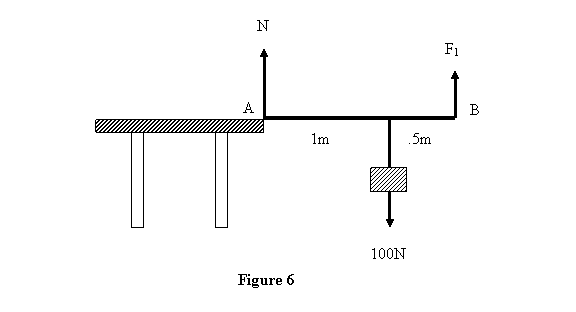
Let the normal reaction of the table on the rod be N and
the force by the point be F1. Then the two
equilibrium conditions give

Example 2: As the second illustration
we take the example of a lever that you may have used
sometime or the other. We are trying to lift a 1000N
(~100kg mass) weight by putting a light weight but strong
rod as shown in the figure using the edge of a brick
as the fulcrum. The height of the brick is 6cm. The question
we ask is: what is the value of the force applied in
the vertical direction that is needed to lift the weight?
Assume the brick corner to be rough so that it provides
frictional force.

(Note: If the brick did not provide friction, the force
applied cannot be only in the vertical direction as that
would not be sufficient to cancel the horizontal component
of N). Let us see what happens if the brick offered no
friction and we applied a force in the vertical direction.
The fulcrum applies a force N perpendicular
to the rod so if we apply only a vertical force, the
rod will tend to slip to the left because of the component
of N in that direction. Try it out on a smooth
corner and see that it does happen. However, if the friction
is there then the rod will not slip. Let us apply the
equilibrium conditions in such a situation. The balance
of forces gives

Let us choose the fulcrum as the point about which we
balance the torque. It gives
Then

The normal force and the frictional force can now be calculated
with the other two equations obtained above by the force
balance equation.
In the example above, we have calculated the torques and
have also used normal force applied on a surface. We
are going to encounter these quantities again and again
in solving engineering problems. So let us study each
one of them in detail.
Torque due to a force: As
discussed earlier, torque about a point due to a force  is
obtained as the vector product
is
obtained as the vector product

where  is
a vector from the point O to the point where
the force is being applied. Actually
is
a vector from the point O to the point where
the force is being applied. Actually  could
be a vector from O to any point along the line
of action of the force as we will see below. The magnitude
of the torque is given as
could
be a vector from O to any point along the line
of action of the force as we will see below. The magnitude
of the torque is given as

Thus the magnitude of torque is equal
to the product of the magnitude of the force and the
perpendicular distance  from O to
the line of action of the force as shown in figure 7
in the plane containing point O and the force
vector. Since this distance is fixed, the torque due
to a force can be calculated by taking vector
from O to
the line of action of the force as shown in figure 7
in the plane containing point O and the force
vector. Since this distance is fixed, the torque due
to a force can be calculated by taking vector  to
be any vector from O to the line of action
of the force. The unit of a torque is Newton-meter or
simply Nm.
to
be any vector from O to the line of action
of the force. The unit of a torque is Newton-meter or
simply Nm.
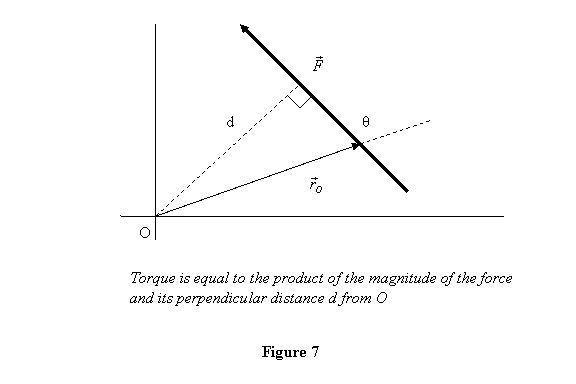
Let us look at an example of this in 2 dimensions.
Example 3: Let there
be a force of 20 N applied along the vector going from
point (1,2) to point (5,3). So the force can be written
as its magnitude times the unit vector from (1,2) to
(5,3). Thus

Torque can be calculated about O by
taking  to
be either
to
be either  .
As argued above, the answer should be the same irrespective
of which
.
As argued above, the answer should be the same irrespective
of which  we
choose. Let us see that. By taking
we
choose. Let us see that. By taking  to
be
to
be  we
get
we
get

On the other hand, with  we
get
we
get

Which is the same as that obtained with  .
Thus we see that the torque is the same no matter where
along the line of action is the force applied. This is
known as the transmissibility of the
force. So we again write that
.
Thus we see that the torque is the same no matter where
along the line of action is the force applied. This is
known as the transmissibility of the
force. So we again write that

where  is
any vector from the origin to the line of
action of the force.
is
any vector from the origin to the line of
action of the force.
If there are many forces applied on a body then the total
moment about O is the vector sum of all other
moments i.e.

As a special case if the forces are all applied at the
same point j then

This is known as Varignon's
theorem.
Its usefulness arises from the fact that
the torque due to a given force can be calculated
as the sum of torques due to its components.
As would be clear to you from the discussion so far torque
depends on the location of point O . If for
the same applied force, the torque is taken about a different
point, the torque would come out to be different. However,
as mentioned earlier, there is one special case when
the torque is independent of the force applied and that
is when the net force(vector sum of all forces) on the
system is zero. Let us prove that now: Consider the torque
of a force being calculated about two different points O and O' (figure
8).

The torques about O and O' and their
difference is:

But from the figure above

Therefore

Now if the net force is zero,  is
zero and the difference between the torques
about two different points also vanishes. A particular
example of the net force being zero is two equal
magnitude forces in directions opposite to each
other and applied at a distance from one another,
as in figure 5 above and also shown in figure
9 below. This is known as a couple and the corresponding
torque with respect to any point is given as
is
zero and the difference between the torques
about two different points also vanishes. A particular
example of the net force being zero is two equal
magnitude forces in directions opposite to each
other and applied at a distance from one another,
as in figure 5 above and also shown in figure
9 below. This is known as a couple and the corresponding
torque with respect to any point is given as


where  is
a unit vector perpendicular to the forces
coming out of the space between them and d is
the perpendicular distance between the forces
(see figure 9).
is
a unit vector perpendicular to the forces
coming out of the space between them and d is
the perpendicular distance between the forces
(see figure 9).
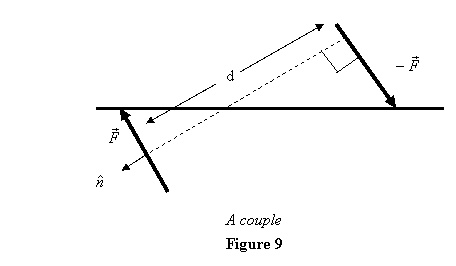
Since the net force due to a couple is zero, the only
action a couple has on a body is to tend to rotate it.
Further the moment of a couple is independent of the
origin, and so it can be applied anywhere on the body
and it will have the same effect on the body. We can
even change the magnitude of the force and alter the
distance between them keeping the magnitude of the couple
the same. Then also the effect of couple will be the
same. Such vectors whose effect remains unchanged irrespective
of where they are applied are known as free vectors.
Free vectors have a nice property that they can be added
irrespective of where they are applied without changing
the effect they produce. Thus a couple is a free vector
(Is force a free vector?). It is represented by the symbols
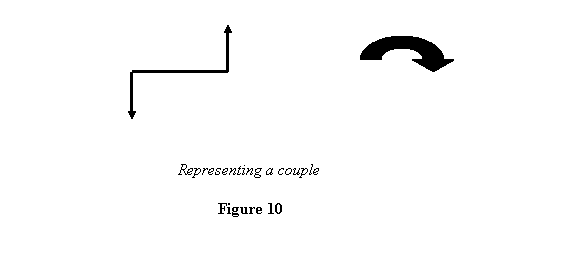
with the arrows clearly giving the sense of rotation.
Keep in mind though that the direction of the couple
(in the vector sense) is perpendicular to the plane in
which the forces forming the couple are.
Next we focus on the moment of a force about an axis.
Moment of force
about an axis: So
far we have talked about moment of a
force about a point only. However, many
a times a body rotates about an axis.
This is the situations you have bean studying
in you 12th grade. For example a disc
rotating about an axis fixed in two fixed
ball bearings. In this case what affects
the rotation is the component of the torque
along the axis, where the torque is taken
about a point O (the
point can be chosen arbitrarily) on the axis
as given in figure 11. Thus

where  is
the unit vector along the axis direction
and
is
the unit vector along the axis direction
and  is
the vector from point O on the
axis to the force
is
the vector from point O on the
axis to the force  .
.
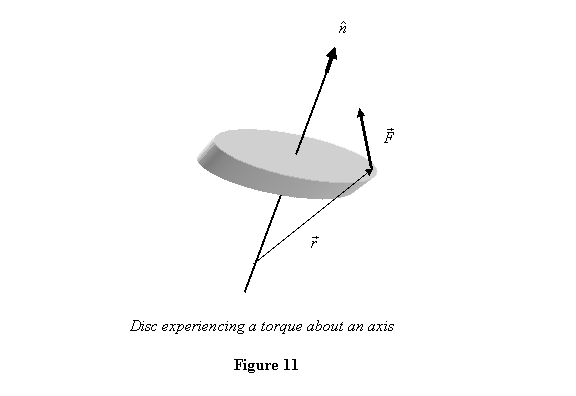
Using vector identities (exercise at the end of Lecture
1), it can also be written as

Thus the moment of a force about
an axis is the magnitude of the component of
the force in the plane perpendicular to the axis
times its perpendicular distance from the axis.
Thus if a force is pointing towards the axis,
the torque generated by this force about the
axis would be zero. This can be understood as
follows. When a force is applied, forces are
generated at the ends of the axis being held
on a one place. These forces together with  generate
the torque when components along the axis
by responsible for rotation of the body about
the axis, in the same manner, the couple about
the axis is given by the component of the couple
moment in the direction for the axis. You can
work it out; it is actually equal to the component
of the force in the plane perpendicular to
the axis times the distance
generate
the torque when components along the axis
by responsible for rotation of the body about
the axis, in the same manner, the couple about
the axis is given by the component of the couple
moment in the direction for the axis. You can
work it out; it is actually equal to the component
of the force in the plane perpendicular to
the axis times the distance  of
the force line of action from the axis. One
point about the moment about an axis, it is independent
of the origin since it depends only on the distance
of
the force line of action from the axis. One
point about the moment about an axis, it is independent
of the origin since it depends only on the distance  of
the force the axis.
of
the force the axis.
As an example let us consider a disc of radius 30 cm with
its axis along the z-axis and its centre at z=0. Let
a force  act
on it at the point
act
on it at the point  on
the disc. We now find its moment about its axis. The
axis has
on
the disc. We now find its moment about its axis. The
axis has  .
We take the origin at the centre of the disc to calculate
.
We take the origin at the centre of the disc to calculate

Therefore the torque about the z-axis is

Thus the torque about the axis is in the negative z direction
which means that it would tend to rotate the disc clockwise.
Let us now see if it fits with
our conventional way of calculating torque of
a force about an axis. For the force  the
z-component of the force will not give any
torque about the z-axis because it cannot rotate
the body about the z-axis. So the only component
of the force that gives torque about the z-axis
is
the
z-component of the force will not give any
torque about the z-axis because it cannot rotate
the body about the z-axis. So the only component
of the force that gives torque about the z-axis
is  that
acts on the point as shown in figure 12.
The magnitude of this force is
that
acts on the point as shown in figure 12.
The magnitude of this force is  .
.
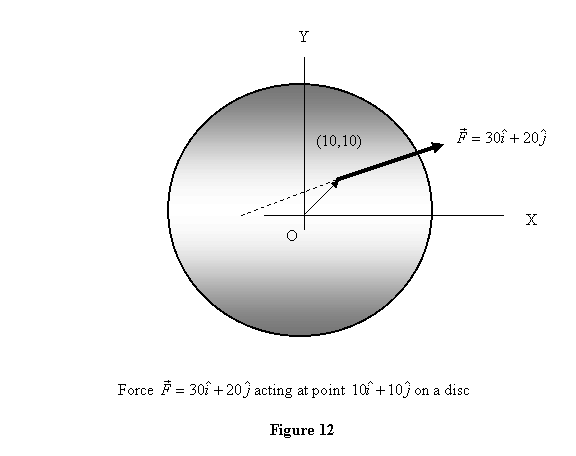
The equation of line along which the force acts is

To find the perpendicular distance
of this line from the origin, we consider a line
perpendicular to this line  passing
through the origin and consider the point
where it intersects with
passing
through the origin and consider the point
where it intersects with  .
The perpendicular line is
.
The perpendicular line is

Solving for the intersection point we get

which gives the perpendicular distance of the line of
force from the centre to be

Then torque about z-axis therefore
is therefore  clockwise,
which is the same as obtained that earlier.
I would like you to notice that even in this
simple example using vector algebra makes life
quite easy.
clockwise,
which is the same as obtained that earlier.
I would like you to notice that even in this
simple example using vector algebra makes life
quite easy.